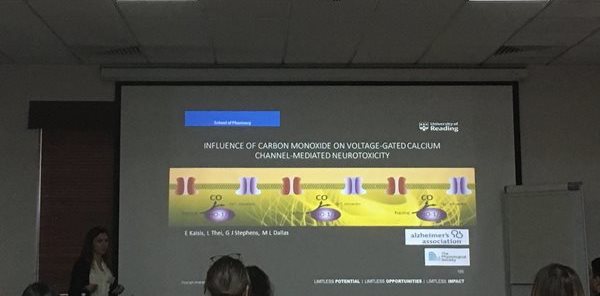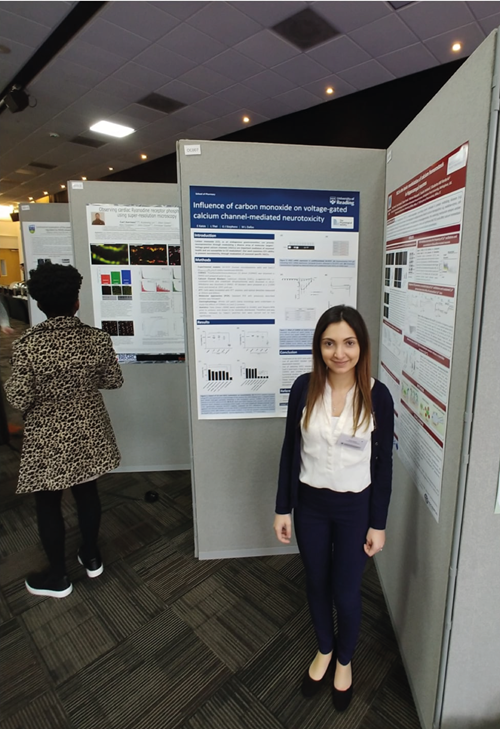The Life Sciences Post-Translational Modifications and Cell Signalling meeting, which took place 17-18 March 2019 at the East Midlands Conference Centre in Nottingham, provided a stimulating forum for cross disciplinary debate. The meeting was co-organised by the British Pharmacological Society, the Physiological Society and the Biochemical Society, with a specific remit to encourage networking and discussion between national and international researchers from across the broad disciplines represented by the Societies.
.jpg.aspx?width=600&height=450)
Figure 1. The symposia sessions included elevated presentations from Early Career Researchers
The meeting attracted 160 national and international researchers to an ideal venue in the heart of the UK. The event kicked off with a keynote lecture from Changwon Kho (Icahn School of Medicine at Mount Sinai, USA), who described how post-translational modification (PTM) of the SERCA2 pump by SUMOylation improves cardiac function in a model of Duchenne Muscular Dystrophy. The second keynote speaker was Qian Wu (University of Leeds), recipient of the Biochemical Society Early Career Research (ECR) award, who gave a fascinating insight into how PTMs, including phosphorylation and ubiquitination, regulated the fundamental process of DNA damage response and repair signalling. Dr Wu’s talk was followed by followed by flash, and conventional, posters. A range of interesting topics were covered and provided opportunity for ECRs to showcase their work to interested parties from different disciplines. Special mention here to Amy Stainthorp (University of Leeds) who was awarded the best poster prize, sponsored by 2BScientific, for work describing a pathway whereby the adaptor protein Grb2 regulates the FGFR2-mediated miRNA biogenesis process.
There was something for everyone in the three parallel symposia programme with pharmacological research represented strongly throughout. A highlight for me was the session organised by Matt Gold (University College London) which included a description of how PTMs are likely to be crucial in the function of alpha2delta auxiliary calcium channel subunits from Annette Dolphin (University College London) and a compelling talk from Moitrayee Bhattacharyya (University of California, Berkeley) on calcium calmodulin-dependent protein kinase II function. Dr Bhattacharyya was one of many ECRs who were proposed, or who were elevated from the submitted abstracts, to make an integral contribution to the final program. One such elevated talk, from Chidinma Okolo (University of Otago, New Zealand) on O-GlcNAcylation of the cardiac ryanodine receptor, was awarded the Best Oral Communication prize sponsored by eLife Sciences. It was the ethos of the conference to promote ECR participation. Eleni Kaisis, a PhD student supervised by Mark Dallas and myself at the University of Reading, gave an ECR oral communication and poster (Figure 2); Eleni commented “As an early career scientist, attending Life Sciences 2019 provided me with a great opportunity to engage with otherscientists, share my work with the wider community and also expand my knowledge of the field”. Mark Dallas commented further “The 2019 Life Science meeting brought together scientists from different disciplines to progress scientific research. With respect to our symposium, it provided an open platform to discuss new ideas and critique each other’s work which are key to making research count.”

Figure 2. Eleni Kaisis prepares to present ahead of a busy poster session
Between the second day symposia, Fiona Marshall, Head of Neuroscience Discovery and Head of Discovery Research at MSD, delivered the British Pharmacological Society’s Vane Lecture. This was an excellent presentation, predominantly on how industry is using strategies to target PTMs, such as the inhibition of O-GlcNAc hydrolase to reduce pathological tau in neurodegenerative disease. The lecture tied up the different biochemical, physiological and biochemical strands to put PTMs firmly into the context of real-world pharmacological drug discovery. To round off day two, an ECR Networking/Careers workshop invited participants to consider ‘what can you do with a life sciences degree?’ Here, a number of speakers each with a range of different professions, including publishing, events, policy, industry, public engagement, and academia made a short presentation about how and why they have followed their particular career path. Attendees then had speed-dating style networking with the speakers. This unique session provided a stimulating forum for discussion and was well received by contributors and ECRs alike.
The meeting ran an additional half day introductory course on “Practical Python: Resources for analysing biological data with Python”. This hands-on session, ran by Mike Knight (University of Bristol) and Emma Rand (University of York) explored the use of Python and associated resources for analysing large biological data sets and was designed to enable participants to install and use Python by the end of the course.
This was an inclusive and friendly meeting; the joint co-ordination and three day format provided a useful precedent for future events.
Comments
If you are a British Pharmacological Society member, please
sign in to post comments.